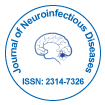An Overview of Encephalitis
DOI: 10.4172/2314-7326.1000336
Abstract
Encephalitis is inflammation of the brain. The severity will be variable with symptoms together with reduced or alternation in consciousness, headache, fever, confusion, a stiff neck, and expulsion. Complications could embracing seizures, hallucinations, hassle speaking, memory issues, and issues with hearing. Brain infections are comparatively rare, however, they're probably serious and have a poor prognosis. The cornerstone of the identification is cerebrospinal fluid (CSF) analysis. Imaging isn't systematic, however, the indications of imaging are broad, notably once round-faced with suspected focal injury, counting on the characteristics of the patient (child, immunological disorder patient, geographic origin, etc.). It’s primarily based on MRI, which permits for etiological identification and extension analysis. Additionally, during a bound range of cases, the sort of infection isn't glorious it's up to the imaging via the use of AN thorough technique to diagnose an infectious origin once round-faced with a mass syndrome.
Keywords: Encephalitis
Introduction
Infections typically begin in different places. They will get to your brain and membrane in many ways. From an infection close, like in your teeth, sinuses, or ears through your blood from another part of your body. Directly from the skin, for instance, through a bone fracture or throughout the operation. Infections that unfold through your blood generally return from bug bites, notably from mosquitoes and ticks. Infections that unfold through your blood generally return from bug bites, notably from mosquitoes and ticks. Headache that is often severe, set during a single section of the top, and can’t be mitigated with painkillers. Changes in condition like confusion or irritability. Problems with nerve performance are like muscle weakness, thick speech, or disfunction on one facet of the body.
Encephalitis has modified through time. For Eg vaccination has LED to a decrease within the incidence of redness thanks to epidemic parotitis The medical specialty of bound microorganism causes of contagious disease while EBV and CMV redness are sawed a lot of oftentimes currently owing to the increase in immunocompromised people. An example is AIDS, transplant, and chemotherapy patients. Bacterial infection may end up in redness particularly in immunocompromised people, true bacteria, Lyme illness, Bartonella henselae, malaria. Autoimmune redness signs will include catatonia, psychosis, abnormal movements, and autonomic dysregulation. Antibodymediated anti-N-methyl-D-aspartate-receptor redness and Rasmussen redness are samples of response encephalitis. Due to the irritation of meningitis covering the brain, indicates that the patient has either infectious disease or encephalitis [1].
Diagnosis
Encephalitis can be difficult to diagnose. This is often a result of different things like an infectious disease, stroke, and general brain tumors that will cause similar symptoms. Neuroimaging, like brain imaging or CT scan. A spinal puncture (spinal tap) to see for signs of infection within the brain or neural structure. Graphical record (EEG) to see for seizures or specific patterns of electrical activity within the brain. MRI imaging reveals T2 hyper intensity in the structures of the medial temporal lobes, and in some cases, other limbic structures. Some cases of limbic encephalitis are of autoimmune origin.
Treatment
Systematic reviews have been unable to draw firm conclusions owing to a scarcity of randomized double-blind studies with adequate numbers of patients and adequate follow-up [2]. Pyrimethamine-based maintenance medical care is usually accustomed to treat Toxoplasmic redness (TE), which is caused by Toxoplasma gondii and is dangerous for folks with weak immune systems [3]. Antiviral medicine – used if redness is caused by the herpes simplex or chickenpox viruses; it’s always given into a vein 3 times each day for two to three weeks steroid injections used if redness is caused by a haul with the immune system and generally in cases joined to the poxvirus; treatment is sometimes for some days.
References
- Shmaefsky V (2010) Meningitis. Infobase Publishing. Archived from the original.
- Mildred A (2017) Intravenous immunoglobulin for the treatment of childhood encephalitis. The Cochrane Database of Systematic Reviews.
- Connolly MP (2017) Toxoplasmic encephalitis relapse rates with pyrimethaminebased therapy: systematic review and meta-analysis. Pathogens and Global Health. 111: 31-44.
Share This Article
Recommended Journals
Open Access Journals
Article Tools
Article Usage
- Total views: 1497
- [From(publication date): 0-2021 - Feb 22, 2025]
- Breakdown by view type
- HTML page views: 917
- PDF downloads: 580
